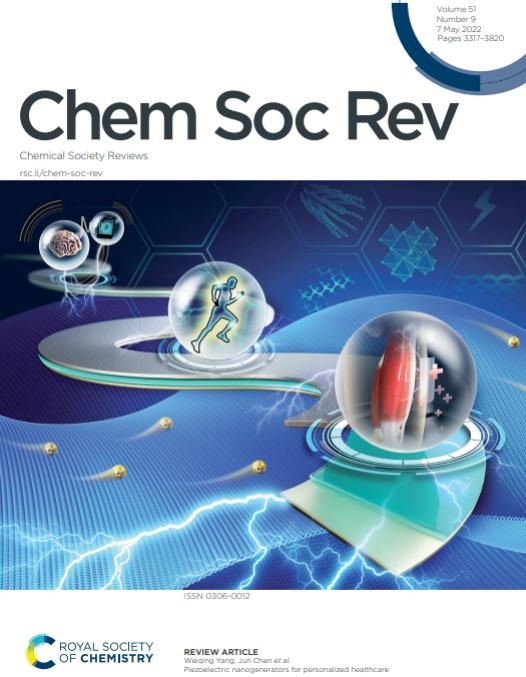以氮基给体配体为重点的发光镧系超分子自组装体系结构的研究进展及未来展望。
IF 39
1区 化学
Q1 CHEMISTRY, MULTIDISCIPLINARY
引用次数: 0
摘要
近几十年来,发光镧系自组装结构的研究已成为一个独立的领域,从单金属到多金属体系的发展趋势明显。一方面,对这些组件的兴趣源于它们的结构多样性和迷人的复杂性,而另一方面,来自镧系离子独特的发光特性,允许它们从材料科学扩展到模拟生物系统的应用。本文首先介绍了单金属Ln3+自组装体的设计和性能方面的最新进展,重点介绍了dpa、pybox和btp等三齿基序和其他非三齿氮给体配体。随后,介绍了多金属体系,包括螺旋体和金属位,以及它们的结构,然后详细说明了如何通过仔细的配体设计来修改整体组装(即螺旋体、四面体、立方体和其他多面体)。还讨论了反阴离子、浓度、金属配体比和溶剂的影响。在包含镧系离子的机械互锁分子中,突出了引人入胜的新进展,重点是它们的结构复杂性和可逆结合特性。此外,本文将重点介绍镧系化合物的功能特性,包括它们的温度依赖性发光,主客体相互作用和聚集诱导发射。简要讨论了这类配体在金属超分子聚合物中的应用,包括它们在发光水凝胶、超分子聚合物和其他常规聚合物中的应用。本文从镧系化合物的生物学特性和毒性、在成像中的应用、镧系化合物的可持续性回收以及在智能材料、传感和诊断等方面的应用等方面进行综述。本文章由计算机程序翻译,如有差异,请以英文原文为准。
Current developments and future perspectives on the formation of luminescent lanthanide supramolecular self-assembly architectures with a focus on nitrogen-based donor ligands.
Research on luminescent lanthanide (Ln) self-assembly structures has emerged into a discrete field with clear evolution from monometallic to polymetallic systems over the last few decades. The interest in these assemblies stems, on the one hand, from their structural diversity and fascinating complexity, while on the other hand, from the unique luminescence properties of the lanthanide ions, allowing for the expansion of their applications from materials science to mimicking biological systems. This review begins with a description of the recent advances in the design and properties of monometallic Ln3+ self-assemblies, with a particular focus on tridentate motifs, such as dpa, pybox, and btp, and other non-tridentate nitrogen donor ligands. Later, polymetallic systems, including helicates and metallocages, are described with their structures, followed by an elaboration on how a careful ligand design allows for the modification of the overall assembly (i.e. helical, tetrahedral, cubic and other polyhedra). The influences of counter-anions, concentrations, metal:ligand ratios and solvents are also discussed. The fascinating new developments within mechanically interlocked molecules containing lanthanide ions are highlighted with a focus on their structural complexity and reversible binding properties. Furthermore, this review will focus on the functional properties of lanthanide assemblies including their temperature-dependent luminescence, host-guest interaction and aggregation-induced emission. The use of such ligands in metallo-supramolecular polymers is briefly discussed, including their application in the generation of luminescent hydrogels, supramolecular polymers and other conventional polymers. We conclude this review with the perspective of exploring the biological properties and toxicity of lanthanide complexes, their application in imaging, and the recovery of lanthanides for sustainable use as well as their promising applications in smart materials, sensing and diagnostics.
求助全文
通过发布文献求助,成功后即可免费获取论文全文。
去求助
来源期刊

Chemical Society Reviews
化学-化学综合
CiteScore
80.80
自引率
1.10%
发文量
345
审稿时长
6.0 months
期刊介绍:
Chemical Society Reviews is published by: Royal Society of Chemistry.
Focus: Review articles on topics of current interest in chemistry;
Predecessors: Quarterly Reviews, Chemical Society (1947–1971);
Current title: Since 1971;
Impact factor: 60.615 (2021);
Themed issues: Occasional themed issues on new and emerging areas of research in the chemical sciences
 求助内容:
求助内容: 应助结果提醒方式:
应助结果提醒方式:


